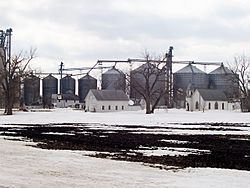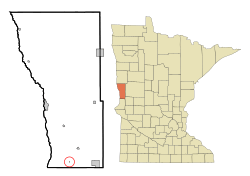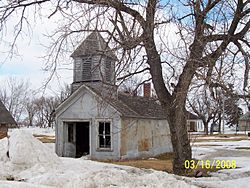Tenney, Minnesota facts for kids
Quick facts for kids
Tenney
|
|
|---|---|

The community of Tenney, viewed from the northeast. None of the buildings in the foreground remain.
|
|

Location of Tenney, Minnesota
|
|
| Country | United States |
| State | Minnesota |
| County | Wilkin |
| Area | |
| • Total | 0.02 sq mi (0.05 km2) |
| • Land | 0.02 sq mi (0.05 km2) |
| • Water | 0 sq mi (0 km2) |
| Elevation | 991 ft (302 m) |
| Population
(2010)
|
|
| • Total | 5 |
| • Density | 250.0/sq mi (96.5/km2) |
| Time zone | UTC-6 (Central (CST)) |
| • Summer (DST) | UTC-5 (CDT) |
| FIPS code | 27-64426 |
| GNIS feature ID | 0653086 |
Tenney is a very small community in Wilkin County, Minnesota, United States. It used to be a city, but it is now an unincorporated community. This means it is not officially governed as a city anymore.
In 2010, only five people lived there. This made Tenney one of the smallest communities in Minnesota. Today, the main part of Tenney that is still active is a large building called a grain elevator. It is located next to the train tracks.
Contents
Where is Tenney?
Tenney is located in the western part of Minnesota. It is in a very flat area that was once the bottom of a huge ancient lake called Lake Agassiz. This land is sometimes called the upper valley of the Red River of the North.
The community is about 2 miles (3.2 km) east of U.S. Route 75. It is also 6 miles (10 km) east of Fairmount, North Dakota. Larger cities like Moorhead, Minnesota are about 63 miles (101 km) south. Minneapolis is much further away, about 170 miles (274 km) to the northwest.
Main Roads Nearby
 U.S. Highway 75
U.S. Highway 75 Minnesota State Highway 55
Minnesota State Highway 55
A Look at Tenney's Past
The city of Tenney was named after John P. Tenney. He owned the land and was willing to give it to the railroad when it came through in 1885. The first house was built by his son-in-law, Fred Maechler.
A post office opened in Tenney in 1887. The city officially became a city on November 30, 1901. At first, the city covered a large area. However, it never grew big enough to fill all that space. So, in 1916, farmers asked to have their land removed from the city, and their request was approved.
Tenney's Busy Years
Around 1910, Tenney's population was at its highest, with about 200 people. Back then, Tenney was a busy place. It had a church, three grain elevators, and many stores. There was a hardware store, two general stores, and a butcher shop. The town also had a bank, a machine shop, and a blacksmith shop. For fun, there was a pool hall. There was even a hotel that also had a barber shop, a saloon, and the post office.
In 1909, a small building was built just for the post office. It was used until 1952. Electricity came to Tenney in 1914, which was a big step forward!
When Tenney Started to Shrink
After 1910, Tenney's population began to get smaller. People started moving to bigger cities for more opportunities. Businesses closed down and were not replaced. For example, the hardware store closed in 1928. The bank closed around 1929 or 1930 after a big stock market crash.
The population continued to drop over the years. By 1970, only 24 people lived there. The post office closed in 1980 when the population was just 19. Today, the only business left in town is the grain elevator.
The population reached its lowest point of 2 people sometime after the year 2000. But by the 2010 census, it had gone up to 5 people. In June 2011, the residents of Tenney voted to officially dissolve the town. This meant it would no longer be a city and would become part of Campbell Township.
What Tenney Looks Like Now
Today, Tenney is very small. It used to cover about two and a half blocks. Now, besides the grain elevator, there are only three homes left. These homes are in different conditions and are used in various ways.
Interesting Places in Tenney
Tenney Fire Hall
The Tenney Fire Hall was a small building made of wood. It had a bell tower and a flag pole. It was built in 1904. This building was important because it housed the town's two fire engines. These were special fire engines that had to be pulled by hand! The back part of the building also had the town's small jail.
The Fire Hall was listed on the National Register of Historic Places. This means it was recognized as an important historical building. Even though it was simple, it was a landmark in the small town. Sadly, this building no longer stands.
City Hall
The City Hall was located on Concord Avenue, which was the main street. It was open to visitors all the time, every day of the year. People were invited to go inside and sign the town's guestbook.
This building was first built in the early 1900s as a community church. It was later a Baptist church. Over the years, it changed names as different church groups used it. From 1968 until 1997, it was the Tenney United Methodist Church. The building was bought in 1999 and was fixed up and made bigger in 2006 and 2007. However, this building has also disappeared from the area.
The Wheaton-Dumont Cooperative Elevator
The Wheaton-Dumont Cooperative Elevator is a very important part of Tenney. It is a large building where farmers bring their grain. In 2003, about 20 million bushels of grain were brought to Tenney and then shipped out by train. A bushel is a way to measure grain. This elevator is connected to the Soo Line Railroad, which is part of the Canadian Pacific Railway.
People of Tenney
| Historical population | |||
|---|---|---|---|
| Census | Pop. | %± | |
| 1910 | 185 | — | |
| 1920 | 102 | −44.9% | |
| 1930 | 80 | −21.6% | |
| 1940 | 89 | 11.3% | |
| 1950 | 62 | −30.3% | |
| 1960 | 35 | −43.5% | |
| 1970 | 24 | −31.4% | |
| 1980 | 19 | −20.8% | |
| 1990 | 4 | −78.9% | |
| 2000 | 6 | 50.0% | |
| 2010 | 5 | −16.7% | |
| U.S. Decennial Census | |||
In 2010, there were 5 people living in Tenney. These 5 people made up 2 households, and both were families. All the residents were White. The average age of people living in Tenney was 56.5 years old. Most of the residents were adults, with 60% being male and 40% female.
Images for kids
See also
 In Spanish: Tenney (Minnesota) para niños
In Spanish: Tenney (Minnesota) para niños




